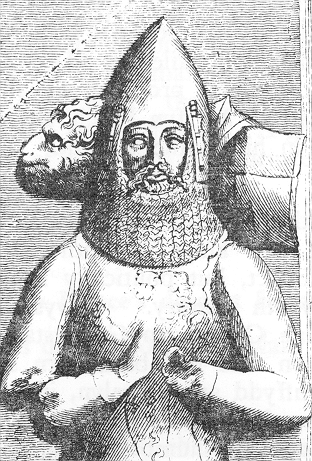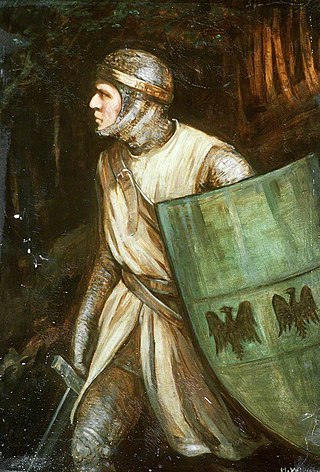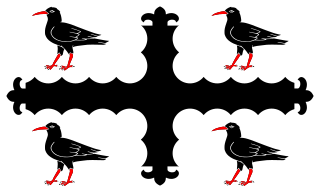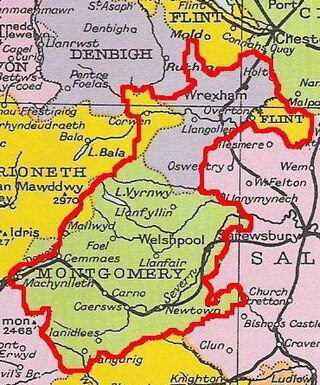Related Research Articles

Rhys ap Gruffydd, commonly known as The Lord Rhys, in Welsh Yr Arglwydd Rhys was the ruler of the Welsh kingdom of Deheubarth in south Wales from 1155 to 1197 and native Prince of Wales.

Llywelyn ap Gruffudd, sometimes written as Llywelyn ap Gruffydd, also known as Llywelyn the Last, was the native Prince of Wales from 1258 until his death at Cilmeri in 1282. Llywelyn was the son of Gruffydd ap Llywelyn Fawr and grandson of Llywelyn the Great, and he was one of the last native and independent princes of Wales before its conquest by Edward I of England and English rule in Wales that followed, until Owain Glyndŵr held the title during the Welsh Revolt of 1400–1415.
Llywelyn the Great was a King of Gwynedd in north Wales and eventually "Prince of the Welsh" and "Prince of Wales". By a combination of war and diplomacy he dominated Wales for 45 years.

Owain ap Gruffudd was King of Gwynedd, North Wales, from 1137 until his death in 1170, succeeding his father Gruffudd ap Cynan. He was called Owain the Great and the first to be styled "Prince of Wales". He is considered to be the most successful of all the North Welsh princes prior to his grandson, Llywelyn the Great. He became known as Owain Gwynedd to distinguish him from the contemporary king of Powys Wenwynwyn, Owain ap Gruffydd ap Maredudd, who became known as Owain Cyfeiliog.

Flintshire, also known as the County of Flint, is one of Wales' thirteen historic counties, and a former administrative county. It mostly lies on the north-east coast of Wales.

The Kingdom of Gwynedd was a Welsh kingdom and a Roman Empire successor state that emerged in sub-Roman Britain in the 5th century during the Anglo-Saxon settlement of Britain.
Hywel ab Owain Gwynedd, Prince of Gwynedd in 1170, was a Welsh poet and military leader. Hywel was the son of Owain Gwynedd, prince of Gwynedd, and an Irishwoman named Pyfog. In recognition of this, he was also known as Hywel ap Gwyddeles. Hywel is also known as the Poet Prince for his bardic skills.

Abenbury is a community in Wrexham County Borough, Wales. It is situated south-east of Wrexham city and includes the village of Pentre Maelor and part of the Wrexham Industrial Estate.

Madog ap Maredudd was the last prince of the entire Kingdom of Powys, Wales and for a time held the Fitzalan Lordship of Oswestry.

The Norman invasion of Wales began shortly after the Norman conquest of England under William the Conqueror, who believed England to be his birthright. Initially (1067–1081), the invasion of Wales was not undertaken with the fervour and purpose of the invasion of England. However, a much stronger Norman invasion began in 1081 and by 1094 most of Wales was under the control of William's son and heir, the later King William II. The Welsh greatly disliked the "gratuitously cruel" Normans, and by 1101, had regained control of the greater part of their country under the long reign of King Gruffudd ap Cynan, who had been imprisoned by the Normans for twelve years before his escape. Gruffudd had some indirect help from King Magnus III of Norway who attacked the Normans briefly off the Isle of Anglesey in northwest Wales near Ynys Seiriol, killing Hugh of Montgomery, 2nd Earl of Shrewsbury.
This article is about the particular significance of the century 1201–1300 to Wales and its people.

Wales in the High Middle Ages covers the 11th to 13th centuries in Welsh history. Beginning shortly before the Norman invasion of the 1060s and ending with the Conquest of Wales by Edward I between 1278 and 1283, it was a period of significant political, cultural and social change for the country.

Wales in the Middle Ages covers the history of the country that is now called Wales, from the departure of the Romans in the early fifth century, the development of regional Welsh kingdoms and Celtic conflict with the Anglo-Saxons, reducing Celtic territories. Conflict also occurred between the Welsh and the Anglo-Normans from the 11th century until the annexation of Wales into the Kingdom of England in the early sixteenth century.

The history of Gwynedd in the High Middle Ages is a period in the History of Wales spanning the 11th through the 13th centuries. Gwynedd, located in the north of Wales, eventually became the most dominant of Welsh polities during this period. Contact with continental courts allowed for Gwynedd to transition from a petty kingdom into an increasingly sophisticated principality of seasoned courtiers capable of high level deplomacy and representation; not only with the Angevine kings, but also the king of France and the Papal See. Distinctive achievements in Gwynedd include further development of Medieval Welsh literature, particularly poets known as the Beirdd y Tywysogion associated with the court of Gwynedd; the reformation of bardic schools; and the continued development of Cyfraith Hywel. All three of these further contributed to the development of a Welsh national identity in the face of Anglo-Norman encroachment of Wales.

The Royal House of Aberffraw was a cadet branch of the Kingdom of Gwynedd originating from the sons of Rhodri the Great in the 9th century. Establishing the Royal court of the Aberffraw Commote would begin a new location from which to rule Wales. The cadet branch achieved the recognised titles of Prince of Wales, King of Wales and were sometimes named King of Aberffraw.

The Battle of Ewloe was a battle fought in July 1157 between a large army led by Henry II of England and an army led by the Welsh prince Owain Gwynedd. The location was marked with a plaque to commemorate 850 years since the battle.
Dafydd ap Llywelyn was Prince of Gwynedd from 1240 to 1246. He was the first ruler in Wales to claim the title Prince of Wales.

Tegeingl, in English Englefield, was a cantref in north-east Wales during the mediaeval period. It was incorporated into Flintshire following Edward I of England's conquest of northern Wales in the 13th century.

Halghton is a dispersed settlement and former civil parish in the east of Wrexham County Borough, Wales. It is part of the community of Hanmer.
English rule in Wales is the period in the history of Wales from the conquest of Wales by Edward I to the Laws in Wales Acts of Henry VIII, during which time Wales was ruled by the English in a colonial manner.
References
- 1 2 3 Edwards, G. J. "Henry II and the Fight at Coleshill" in Welsh History Review , v3, 3 (1967), 257
- ↑ Davies, E. (1959) Flintshire Place-names, UWP, p.39
- ↑ Davies (1959), p.40
- ↑ Edwards (1967), 260
- ↑ Davies (1959) p.44
- ↑ "Coleshill, Battle in 1150, near Flint (404847)", Coflein, RCAHMW , retrieved 8 April 2023